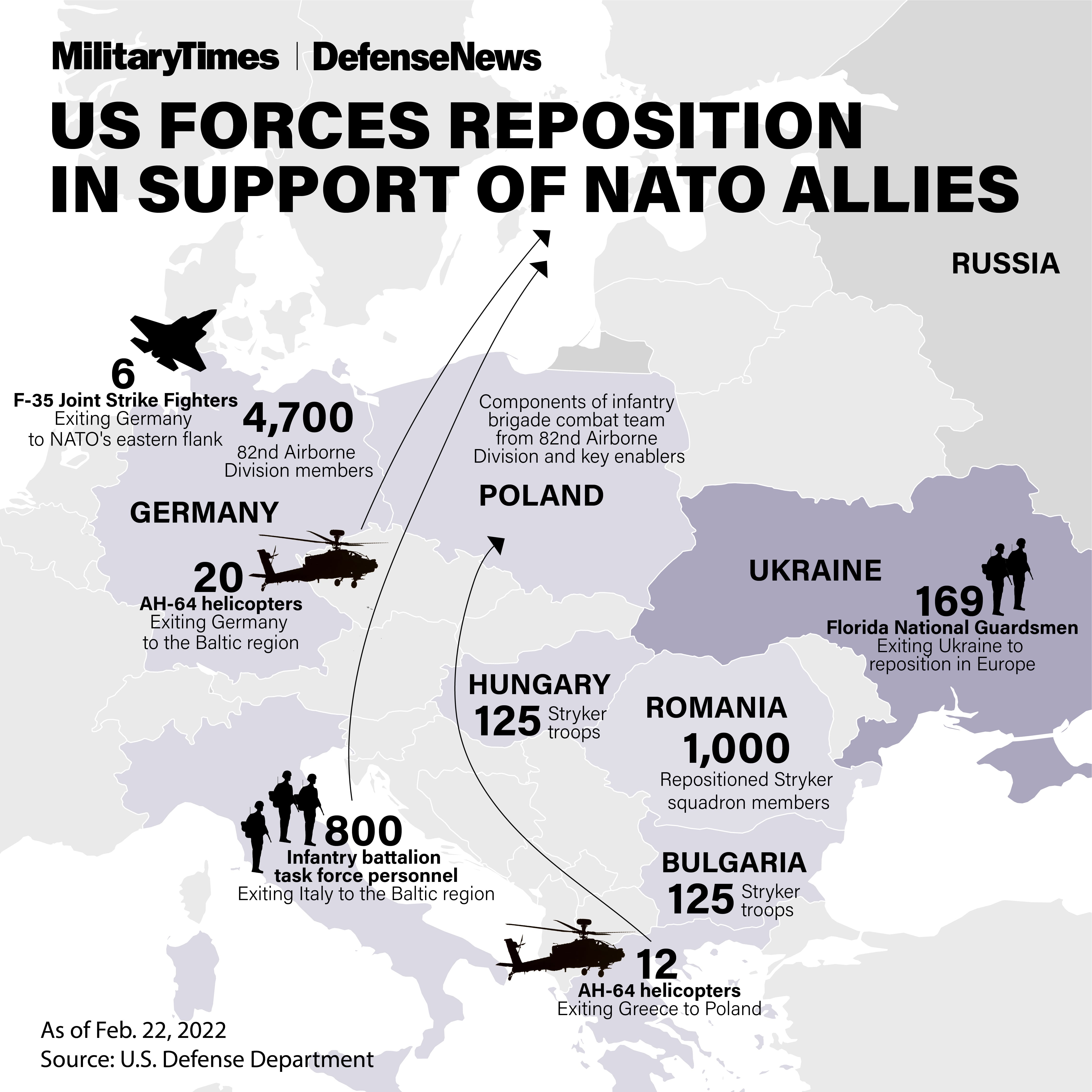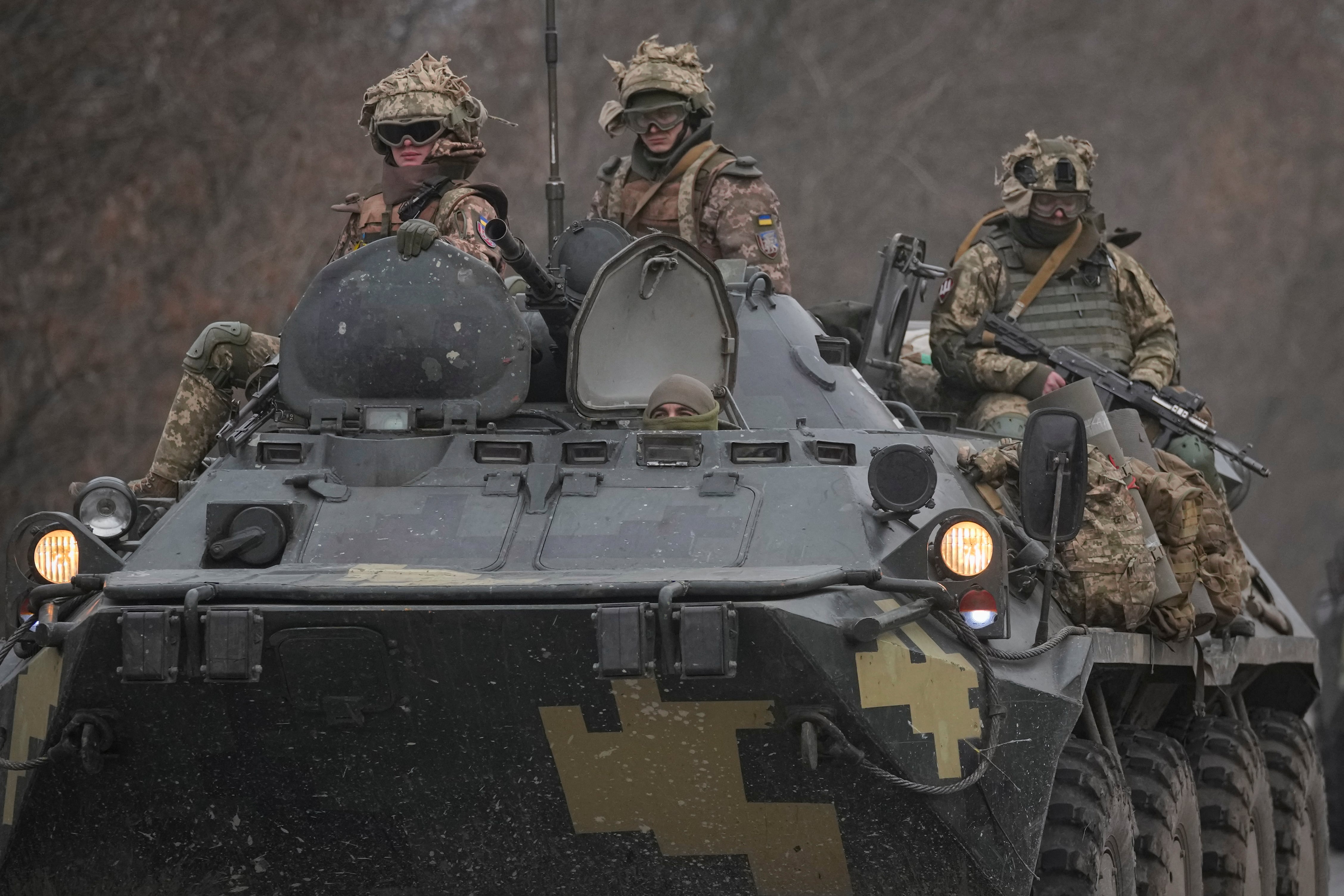This story was updated at 6:53 p.m. to include additional information about U.S. Air Force activity in Europe.
As Russia presses its attack against Ukraine, the U.S. military is pushing forces closer to that embattled nation.
Six Air Force F-35 fighter jets are due in Estonia, Lithuania and Romania on Thursday as Russian and Ukrainian forces continue to clash outside of Ukraine’s major cities, a senior defense official told reporters.
Another 32 AH-64 Army Apache helicopters are also set to arrive in Poland and the Baltic states on Thursday, the official said, as part of a build up of thousands of U.S. troops to reassure NATO allies as Russia makes moves toward a full takeover of Ukraine.
On the ground, the official said, thousands of soldiers from the 82nd Airborne Division are prepared to assist any American refugees who come across Ukraine’s border into Poland.

“They’re poised to support, but I don’t have an update for you in terms of whether they’re actually anybody at their facilities at this time,” the official said, later adding that there has been an increase in people heading across the border in general.
Roughly 4,700 paratroopers from the 82nd Airborne Division were sent to Poland in recent weeks. Another 3,800 soldiers from a 1st Infantry Division armored brigade have also been in the country since August as part of a regular rotation of forces. Paratroopers in Poland have set up at a military airport near Mielec, about 90 miles from the Ukrainian border by road. Another 1,000 soldiers from the Germany-based 2nd Cavalry Regiment were dispatched to Romania. And a battalion of paratroopers from the Italy-based 173rd Airborne Brigade are heading to Latvia, as well.
Since the fighting began early Thursday morning in Ukraine, the Defense Department has been able to confirm that attacks have targeted military barracks, ammunitions storage and airfields.
“We do not have a good sense of of total damage,” the defense official said. “As you might expect, we do not have a good sense of casualties, civilian and or military.”
Russian ground forces began to move later in the morning, he said, adding that there has been no confirmation that troops undertook an amphibious assault from the Black Sea. Indications are that troops air assaulted, fast-roping down from helicopters, into Kharkiv.
“We haven’t been surprised by what we’ve seen thus far,” the official said.
RELATED

The official also could not confirm reports that Ukraine had shot down multiple Russian jets.
Air Force Lt. Col. Tyson Wetzel, an intelligence officer and military strategist currently working as an Atlantic Council fellow, said in an online briefing late Wednesday he believed Russian air and naval forces would work to control Ukrainian airspace and the sea as daylight broke there Thursday.
“I think what we’re seeing right now are the initial standoff strikes,” he said.
Those would take out the surface-to-air missiles that protect Ukraine from overhead attack, allowing Russian jets to patrol the skies so their ground and naval forces can move around the country more freely, Wetzel said.
The opening moves of the Russian air campaign likely aim to sever military units’ ties to their commanders — “cut the head off of the snake, if you will,” Wetzel said. Interrupting Ukrainian troops’ access to command, their leaders’ control, and communications more broadly can hurt their ability to slow Russia’s advance.
Experts said ahead of the invasion that the air defense systems were perhaps the most vulnerable aspect of Ukraine’s military protection.
“The United States set the tone for this type of attack in 1991 in the opening hours of [Operation] Desert Storm,” Wetzel said. “It is a methodology that still works today.”
For now, the U.S. is not flying any reconnaissance missions over the country, nor able to use aircraft to bring aide to Ukraine.
The F-35s will police NATO airspace over the Baltic and Black Sea regions from Estonia’s Amari Air Base, Lithuania’s Siauliai Air Base and Romania’s Fetesti Air Base, the service said in a release.
“Why are they in the Baltics? It’s assurance, deterrence and, quite frankly, I think they’ll do training as well, depending on how the situation evolves,” a senior F-35 official told Air Force Times on Wednesday.
Defense Secretary Lloyd Austin nor Army Gen. Mark Milley, chairman of the Joint Chiefs of Staff, were at the White House on Thursday morning, the senior defense official told reporters.
“I would not rule out or take off the table … the possibility that there’ll be additional repositioning inside Europe or even flow from outside Europe,” he said.
Multiple U.S. Air Force tankers were airborne Thursday to refuel jets patrolling the skies as part of NATO’s air policing mission and other movement around the region. Alongside the F-35s, the United States has currently dispatched F-16 Fighting Falcon and F-15 Eagle fighter jets to Romania, Poland, Estonia and Lithuania.
Cargo aircraft, including several C-17 Globemaster III and C-130 Hercules planes, and intelligence-collection assets are “actively executing their mission throughout Eastern Europe,” U.S. Air Forces in Europe spokesperson Capt. Daniel de La Fé said.
Flight trackers showed three NATO E-3 airborne target tracking planes in the nearby skies Thursday morning, as well as an American E-8C ground target tracking jet and RC-135 signals intelligence plane. Open-source flight radar also showed an RQ-4 Global Hawk reconnaissance drone circling over the Black Sea, where Russia has amassed naval forces.
Farther north, two B-52 Stratofortress bombers linked up with the Swedish and Polish militaries for previously planned joint aviation training. The Cold War-era bombers, which can carry conventional and nuclear weapons, worked with Swedish troops who called in airstrikes in practice runs in the Arctic, and partnered with Polish MiG-29 fighters for a show of force in the Baltics, the Air Force said.
”USAFE is postured and ready to adjust forces as necessary to support a range of options for NATO and Department of Defense leaders, and we are working closely with NATO allies and partners to coordinate aircraft maneuvers throughout the theater,” de La Fé told Military Times.
Meghann Myers is the Pentagon bureau chief at Military Times. She covers operations, policy, personnel, leadership and other issues affecting service members.
Rachel Cohen is the editor of Air Force Times. She joined the publication as its senior reporter in March 2021. Her work has appeared in the Washington Post, the Frederick News-Post (Md.), Air and Space Forces Magazine, Inside Defense, Inside Health Policy and elsewhere.
Kyle Rempfer was an editor and reporter who has covered combat operations, criminal cases, foreign military assistance and training accidents. Before entering journalism, Kyle served in U.S. Air Force Special Tactics and deployed in 2014 to Paktika Province, Afghanistan, and Baghdad, Iraq.





